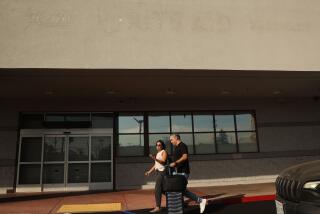Pre-HMO Days, When the Pharmacy Was Fun
Rx for fun: Browse through “Do Pharmacists Sell Farms?”--a paean to that fast-disappearing American institution, the corner drugstore (Simon & Schuster).
All that’s missing from Vince Staten’s text is that delicious vanilla smell that permeated the premises of real drugstores--before the arrival of giant chains that sell everything from lozenges to lawn furniture.
Alas, observes Staten, “drugstores just aren’t the integral part of our lives they once were”--the average American family visits one only 16 times a year. Only the Geritol set is likely to remember soda fountains that dispensed cherry Cokes and the joys of browsing through movie magazines (without buying).”
Staten’s book is a social history of drugstores and the products they sold, including the aforementioned Geritol, in the 1950s an alcohol-laced concoction wildly popular as an antidote to “tired blood.”
Ever wonder why pharmacists sit on those high stools? It started when drugstores, with their ever-expanding stock, had to go self-service. Sitting up there, old Doc Friendly could keep an eye on the customers while mixing up his potions.
Alas, the family pharmacist--who practiced medicine without a license and was also a font of neighborhood gossip--is an endangered species. Today, card-carrying HMO members are just numbers in a computer. And pharmacists don’t need mortars and pestles to dispense pills.
It’s well known that an Atlanta pharmacist invented Coca-Cola, but did you know how Maybelline came to be? Seems that a Chicagoan, T.L. Williams, got the idea while watching his sister Mabel applying her homemade mascara of petroleum jelly and black pigment. When his product, Lash-Brow-Ine, bombed, he renamed it Mabel-ine, which became Maybelline.
Pharmacists of note have included Sydney Porter, who changed his name and his profession and became O. Henry. Onetime soda jerks include Harry Truman, Bob Dole and Lucille Ball.
Before there was Viagra, there was “Dr.” John Brinkley, who bought a medical diploma for $100 and did right well pitching his cure for “falling manhood” until the Feds caught up with him in 1930.
Staten’s trove of drugstore lore includes the information that Tylenol is America’s No. 1-selling drugstore item (in 1995, Americans bought more than $329 million worth). Revlon cosmetics are a distant second, followed by Cover Girl and Maybelline.
The book by the bald-domed Staten includes a month-by-month account of his experiment with Rogaine, which, he estimates, yielded him exactly 28 hairs after four months. He might have done as well with the “cure” by the hair-impaired Hippocrates concocted from horseradish, beet root, spices, opium and pigeon droppings.
Speaking of hair, Staten informs us that, whereas only 5% of American women are natural blonds, 35% are blond or blond-ish. The blond boom started in the ‘50s with Clairol’s question: “Isn’t it true that blondes have more fun?”
Today, Clairol leads the $2-billion-a-year hair-color market, a market that includes half of all American women between the ages of 13 and 70--and one in eight males over 35. Considering the expense of upkeep, Staten observes, “They should give hair color away to the first-timers.”
Which led Staten to ask, “How does Grecian Formula know what color your hair used to be?” It doesn’t.
Other questions posed by the author:
Did Trojans use Trojans? Yes (well, crude condoms).
Whatever happened to Preparations A-G? They never existed.
More to Read
Sign up for The Wild
We’ll help you find the best places to hike, bike and run, as well as the perfect silent spots for meditation and yoga.
You may occasionally receive promotional content from the Los Angeles Times.






